
 |
Eager Space | Videos by Alpha | Videos by Date | All Video Text | Support | Community | About |
|---|

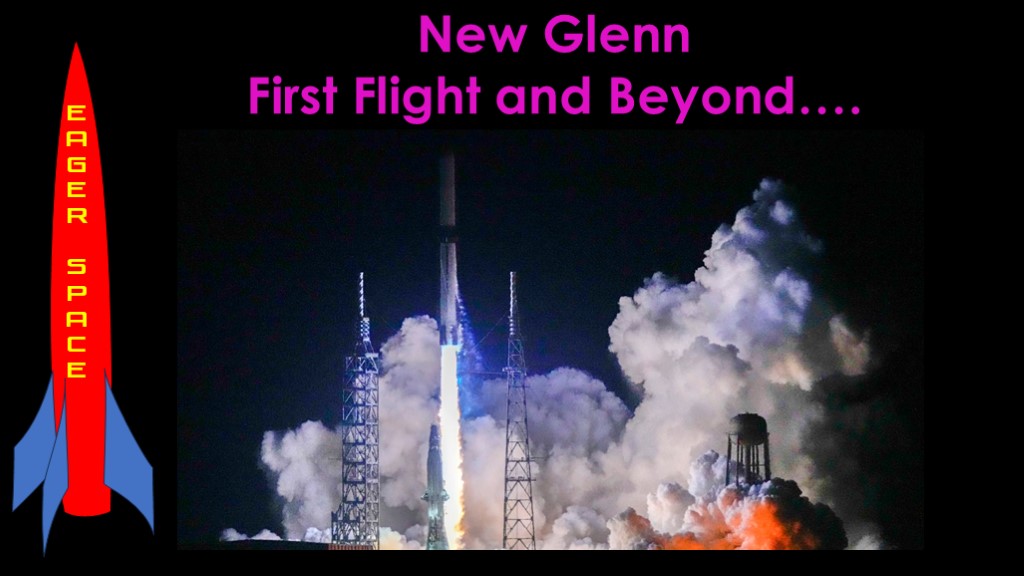
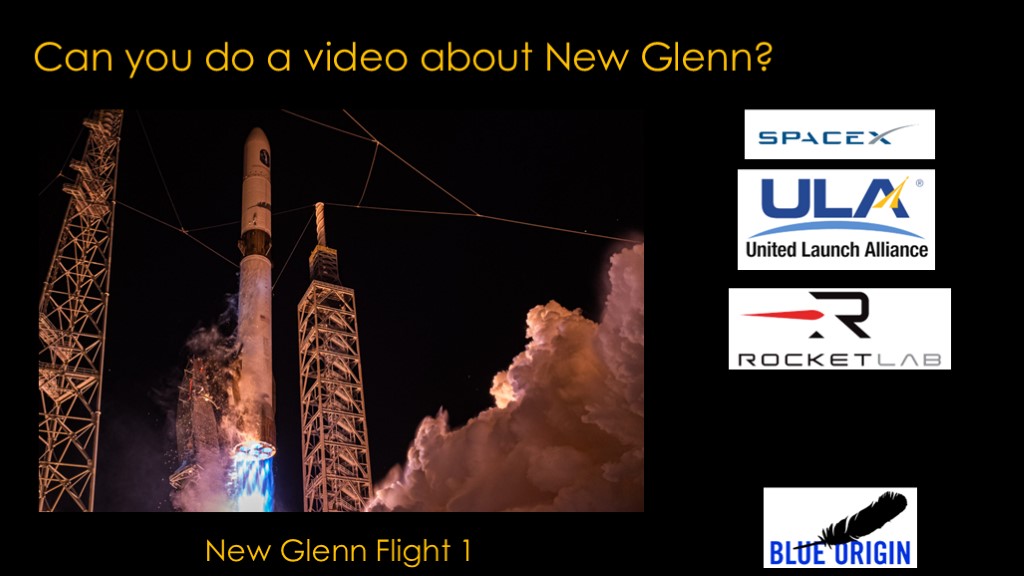
Can you do a video about New Glenn?
I've been asked this question quite a few times, and my response has always been the same.
I do my best not to speculate, or at least to hang my speculations on information that feels reasonably firm.
SpaceX is a very open company, and blue origin is a very closed company, giving out very little information.
And I would say that ULA and Rocket Lab are in the middle, also giving out useful information but perhaps not as much as I would like.
To be worth a video, I need to find something interesting to talk about. Vulcan's interesting because of its interaction in the NSSL launch market and how it differs from Atlas V and Delta IV. Neutron's interesting - and maddening - because I suspect they are doing something pretty unique but we are missing some very real details.
New Glenn? Well, it's a big rocket that has been under development for well over a decade and it's mostly a big version of Falcon 9. Without more data, I didn't have much to say.
But flight one has changed that, and - as a skeptic of New Glenn and Blue Origin in general - I decided to see what I could glean from a single flight and any other information I could find.
And it turns out to be more than I expected.
My usual caveats about any numbers being wrong apply, and to a greater degree than usual.
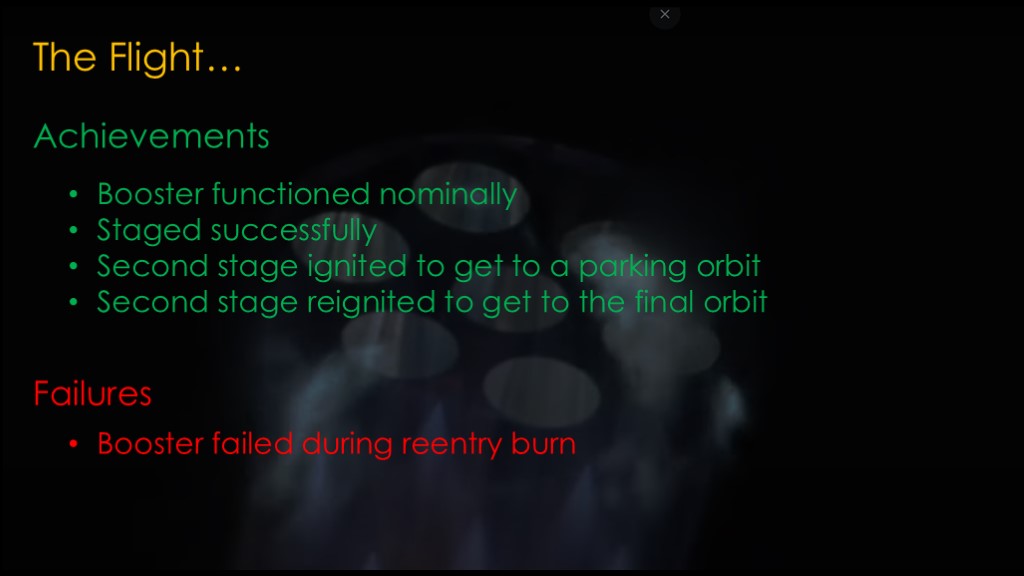
The flight was great. The booster functioned nominally, the rocket staged successfully, and the second stage worked both on initial ignition and when it was reignited. Very similar to what ULA's Vulcan achieved on its first flight. But unlike Vulcan, New Glenn had the goal of landing the booster, and the booster failed early in the reentry burn.
Overall, the mission was a great success, and though they failed in recovery, they presumably got good data from the stage before the failure and will be in a better position for the next try.
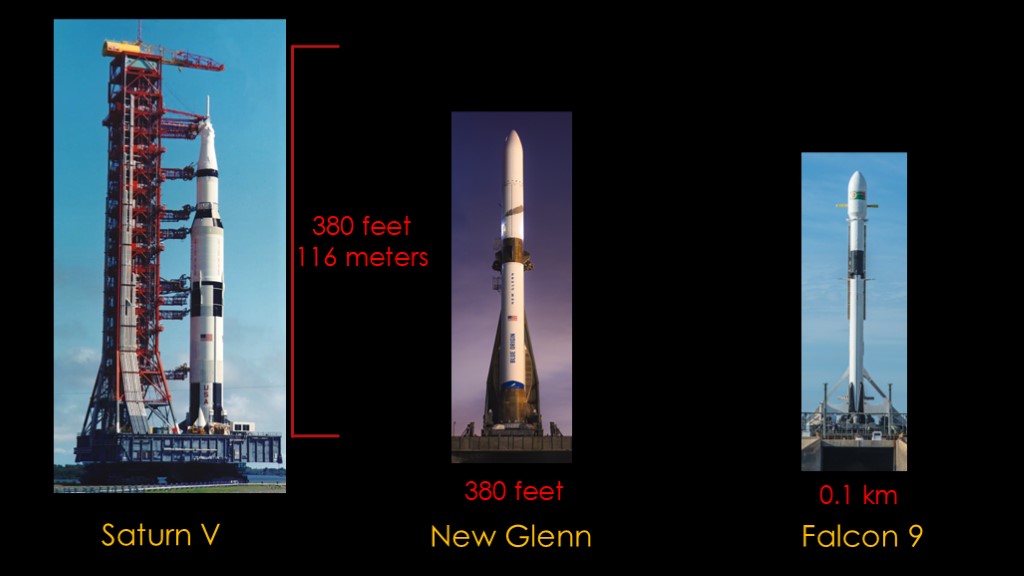
There was one thing that seemed odd, and it was that the rocket seemed to be very slow off the pad.
Which I'm going to use as a jumping off point for a bigger topic.
But first, we're going to do a rocket liftoff race...
Joining New Glenn will be the Saturn V flying the Apollo 11 mission, chosen because it has a reputation for being a slow launcher.
And I've also asked Falcon 9 to participate as a rocket that is reputed to be quick off the pad.
Now we need to decide how long the race is going to be, and this presents a bit of a problem. We have launch footage of the Saturn V but no direct telemetry. I have therefore decided to set the finish line at 380 feet or 116 meters in altitude, the height of the launch tower used on the Saturn V. The Saturn V will be timed until the base of the rocket gets to the top of the tower.
New Glenn reports altitude in feet, so we can just easily target the point where it has gained 380 feet from its initial altitude.
Falcon 9 is a bit harder. The first reported altitude for Falcon 9 is 0.1 km, which is about 320 feet, so I'm going to try to pick that point and round the time up to the next second. It will be close enough.

Here are 3 videos, all starting at the point where I first saw the rocket move upwards.
Let's race.
The Falcon 9 hits the target altitude first, at about 9 seconds. No real surprise there.
I was always under the impression that the Saturn V was slow and lumbering, but it finishes at about 10 seconds. I think it just looks slow because it's such a big rocket. And then finally, New Glenn hits the target about at about 14 seconds. That was a really slow liftoff.
And because I know you are going to ask, Starship Flight 7 took 9 seconds to get to the same altitude, so pretty much the same as the Falcon 9 and Saturn V.
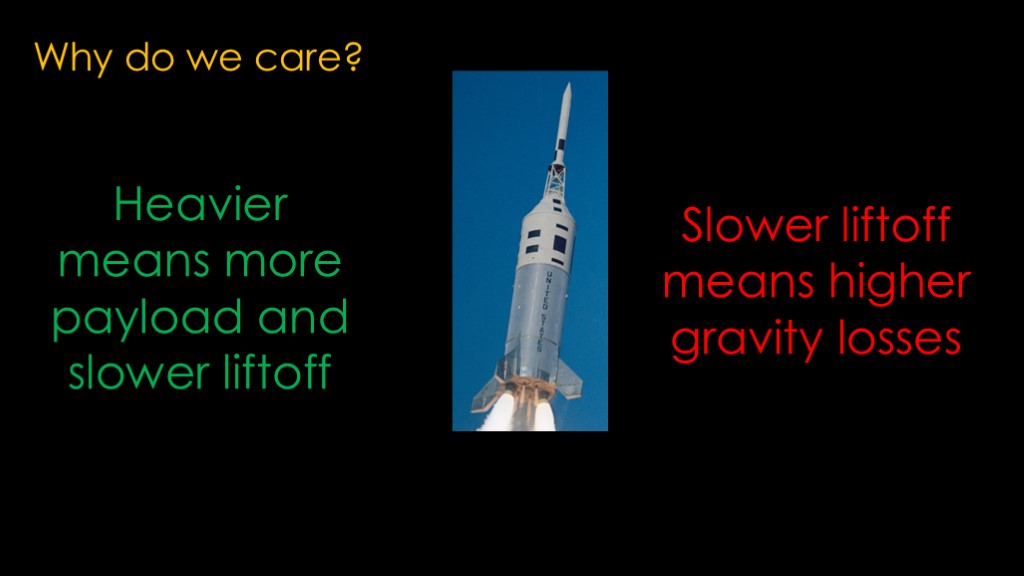
Why do we care?
The liftoff speed is a tradeoff of two competing factors.
If your rocket is heavier that gives you the potential to carry more payload but the rocket takes off slower.
Slower liftoff means higher gravity losses; it takes you longer to generate a given amount of speed and altitude, and every second you waste energy fighting against gravity.
Pure liquid fueled launchers tend to look very similar when they take off as they're designed to a point where these two factors balance out and that gives the highest payload. Rockets that use solids might be different, though the second launch of Vulcan also took about 9 seconds to get to around 380 feet.
The question is "what is going on with New Glenn?" Why does it take off so slow? To understand that we need to know a lot more about the rocket.
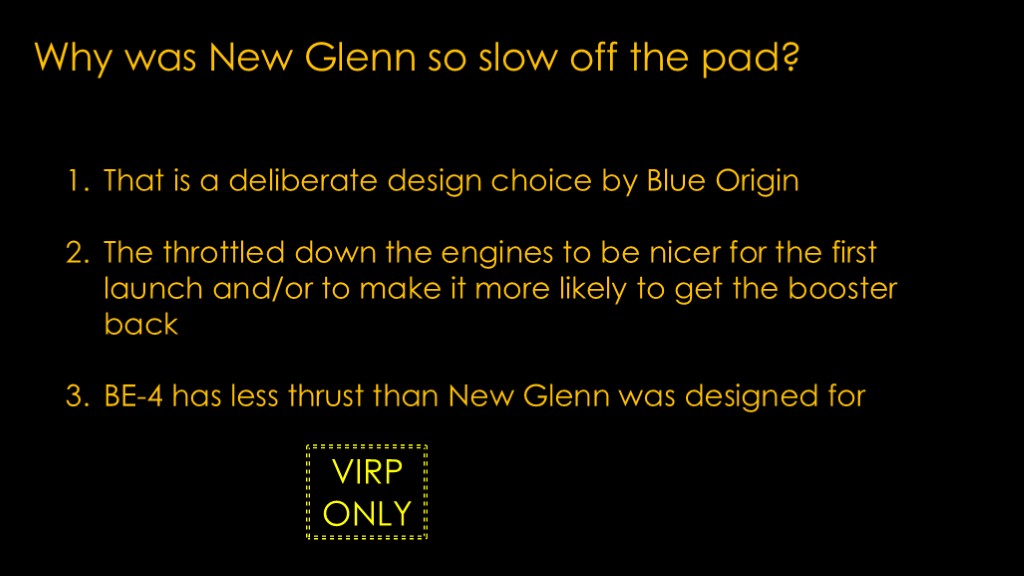
The question at this point is "why does New Glenn take so long to get off the pad?"
I came up with 3 hypotheses.
To evaluate them to see which one is most likely, we need more data.
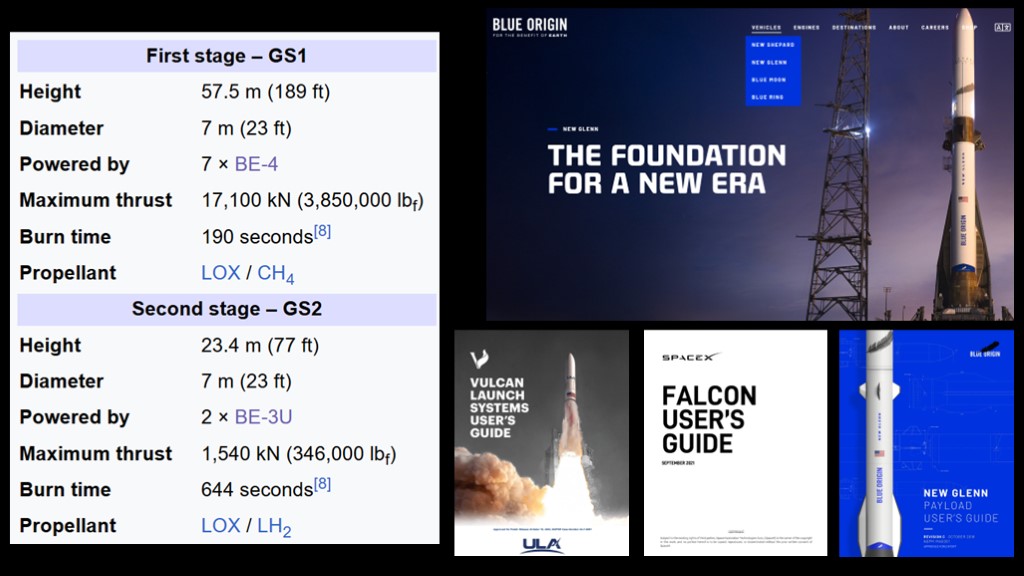
(note the burn times given here - they might be relevant later on).
My first place to start is generally Wikipedia, but the New Glenn Wikipedia page has very limited information, and the New Glenn website is equally lacking in data.
What I'd really like is a current New Glenn user's guide, what customers read to understand how to work with a specific launcher. Vulcan has a nice one, Falcon has a decent one, but the current one for New Glenn is limited to very important rocket people, and at least so far, I do not meet that bar.
And I'm therefore forced to rely on a seven-year-old version of the New Glenn payload user's guide.
We're going to see how much of a model we can build based on the information that we have.
And, as an aside, I highly recommend spending some time reading user's guides. They provide a lot of information about a rocket.
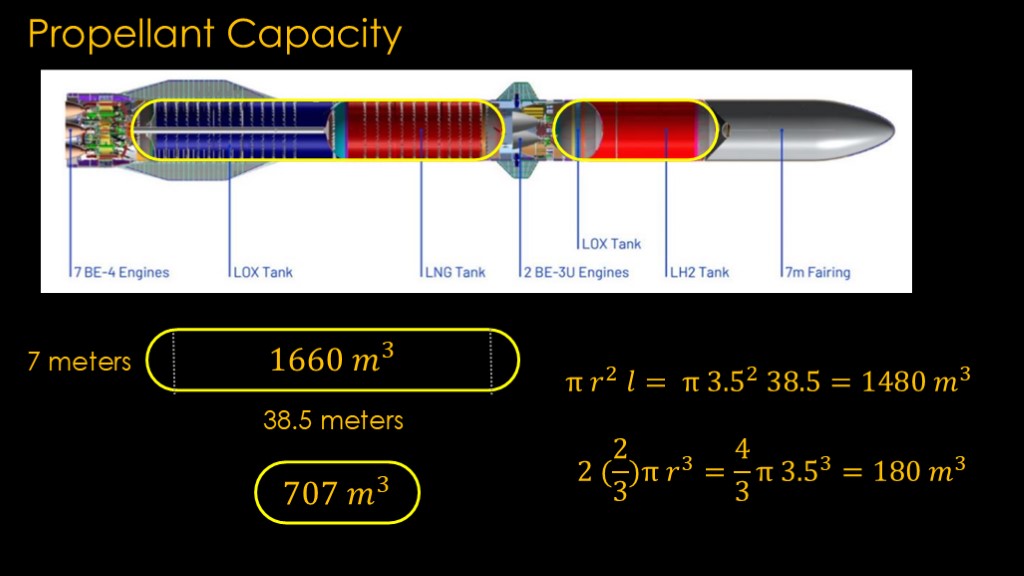
One of the main factors that controls rocket performance is the amount of propellant you can pack into your rocket.
The old Payload User's Guide doesn't give us the numbers we want, but it does have this very useful diagram, and - from what I can tell - this is basically the same design used by the current New Glenn. We're going to do a bit of engineering math and see what we can figure out. Luckily, the physics of rockets is simple.
The first stage propellant tanks are nicely outlined, and since we know that the diameter of the rocket is 7 meters, we can estimate that the length of the cylindrical part of the first tank is 38.5 meters. We can therefore determine the volume of the cylindrical section and the two dome sections, and after a little math we determine that the volume of the tank is 1660 cubic meters. I'm ignoring the shared dome between the two tanks, strengthening ribs, etc.
Using the same approach, we determine the second stage tanks hold 707 cubic meters of propellant.
Knowing the volume of propellant is useful, but what we really want to know is the mass of the propellant. For that, we'll need to do a little more work.
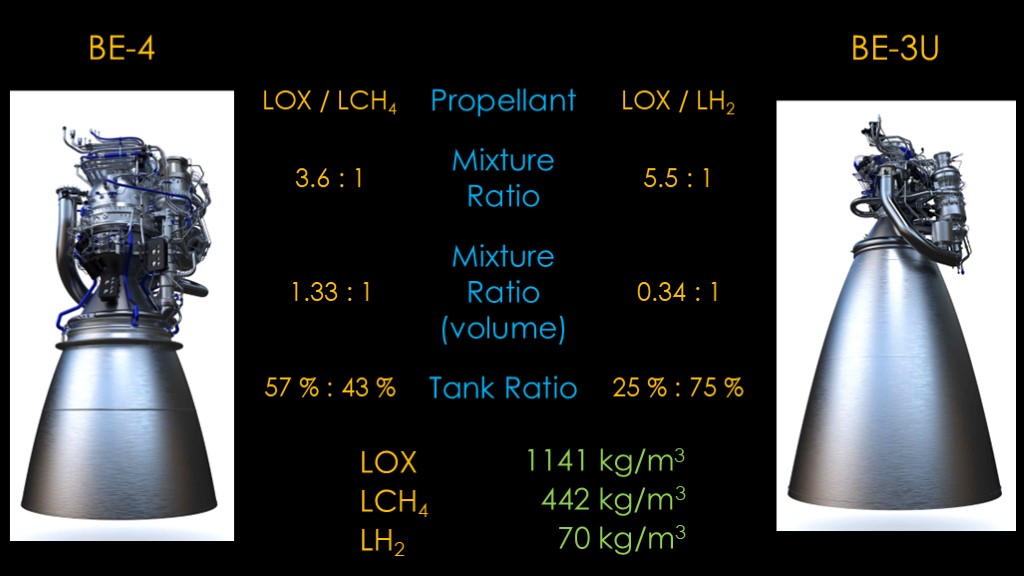
The first stage of new glenn is powered by 7 BE-4 engines, and the second stage is powered by two BE-3U engines.
The BE-4 uses liquid oxygen and liquid methane, while the BE-3U uses liquid oxygen and liquid hydrogen.
The amount of each propellant that the engine uses - known as the mixture ratio - is broadly defined by the chemistry of the propellants. We don't know the exact mixture ratios because Blue Origin won't tell us, but most methane engines run at about 3.6 parts oxygen to 1 part methane, and hydrogen engines run at about 5.5 parts oxygen to 1 part hydrogen.
Mixture ratios are expressed in terms of mass, while what we need is a mixture ratio based on volume, which we can get by using the densities of each propellant. Liquid oxygen is quite dense at 1141 kilograms per cubic meter, liquid methane comes in at 422 kilograms per cubic meter, and liquid hydrogen is the least dense at 71 kilograms per cubic meter. That gives us a volume mixture ratio of 1.33 to 1 for the first stage and 0.34 to 1 for the second stage.
And then finally, we can use that to calculate the tank ratio - the percentage of volume that each propellant occupies in the tanks.
For the first stage, the oxygen tank uses 57% of the space and the methane tank uses 43 percent of the space. We need 3.6 times more oxygen than methane by mass, but liquid methane takes 2.7 times more space because it is less dense, so the tank sizes come out nearly the same.
For the second stage, liquid oxygen is 16.3 times denser than liquid hydrogen, so even though we need 5.5 times more oxygen, hydrogen is very undense so even a small amount takes up most of the tank space. It's about 25% of the space for oxygen, 75% of the space for hydrogen.
We can now check our numbers against the diagram.
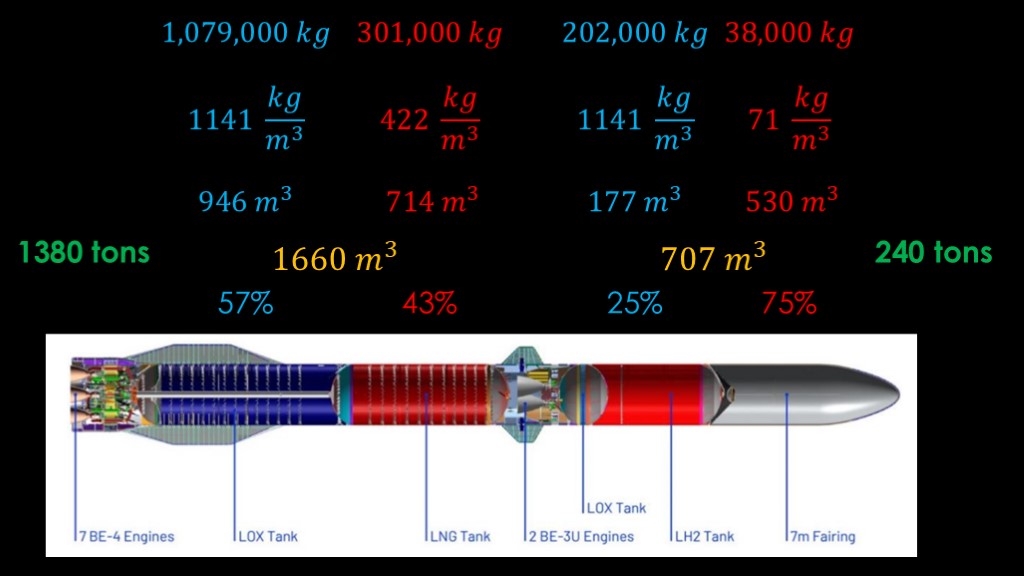
The sizes depicted in the drawing look reasonably accurate.
We know the total size of the tanks, so we can multiply the tank percentages by that to figure out how much volume of each propellant is can fit in its allocated space.
And then we can multiply that by the density of the propellant, and we find out that the first stage has 1,079,000 kilograms of liquid oxygen and 301,000 kilograms of liquid methane, while the second state has 202,000 kilograms of liquid oxygen and 38,000 kilograms of liquid hydrogen.
That gives us a total propellant mass of 1380 tons for the first stage and 240 tons for the second stage.
Since I went to all this trouble, presumably I'm hoping to do something useful with the data. Since we started wondering about the slow liftoff, let's start by calculating the thrust to mass ratio.
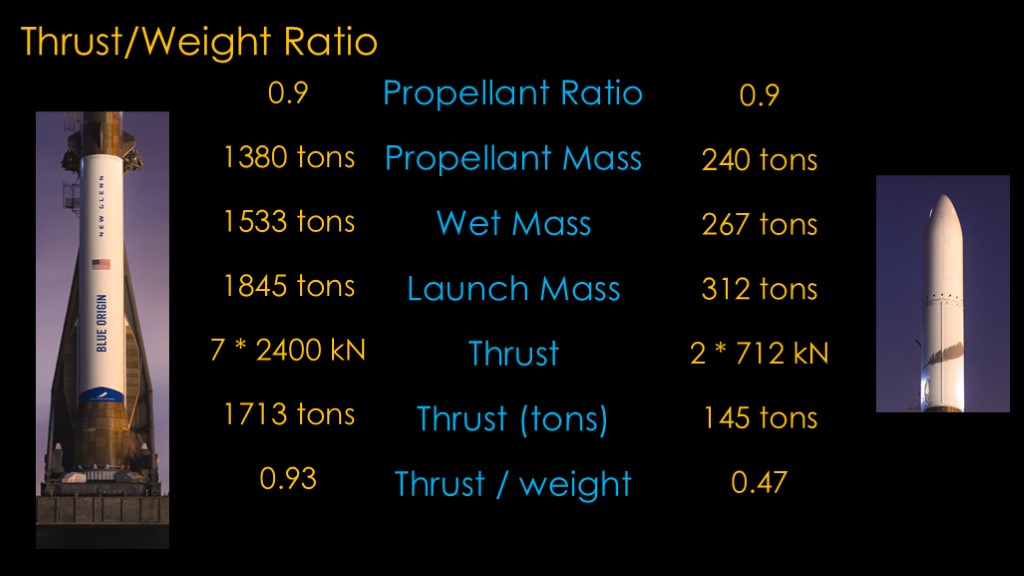
For that we need to know the mass of the empty stages. Blue Origin doesn't want to tell us, so we need a benchmark.
Vulcan also uses a liquid methane first stage and a hydrogen second stage, and for both of those stages, 90% of the wet mass is propellant. That's probably overly optimistic for the New Glenn second stage and ignores the recovery mass for the first stage , but we will roll with it.
Going with that ratio, we would expect the stages to have a wet mass of 1533 and 267 tons. The seconds stage can carry a 45 ton payload, so it has a launch mass of 312 tons, and the first stage has to carry the full second stage, giving a launch mass of 1845 tons.
The engine thrust values are published, and we can convert from kilonewtons to tons of thrust.
That gives us a thrust/weight ratio of 0.47 for the second stage. It's typical for second stage thrust/weight to be less than one as gravity losses are reduced on second stage trajectories, and 0.47 is pretty close to the Centaur III on the Atlas V.
The surprise is the first stage thrust to weight, which comes out as 0.93. If that's correct, New Glenn doesn't get off of the pad. It clearly does, so it means the thrust values are higher than published or the launch mass is less than calculated.
Let's put that puzzle aside for a few minutes, because there's one more calculation I want to do...
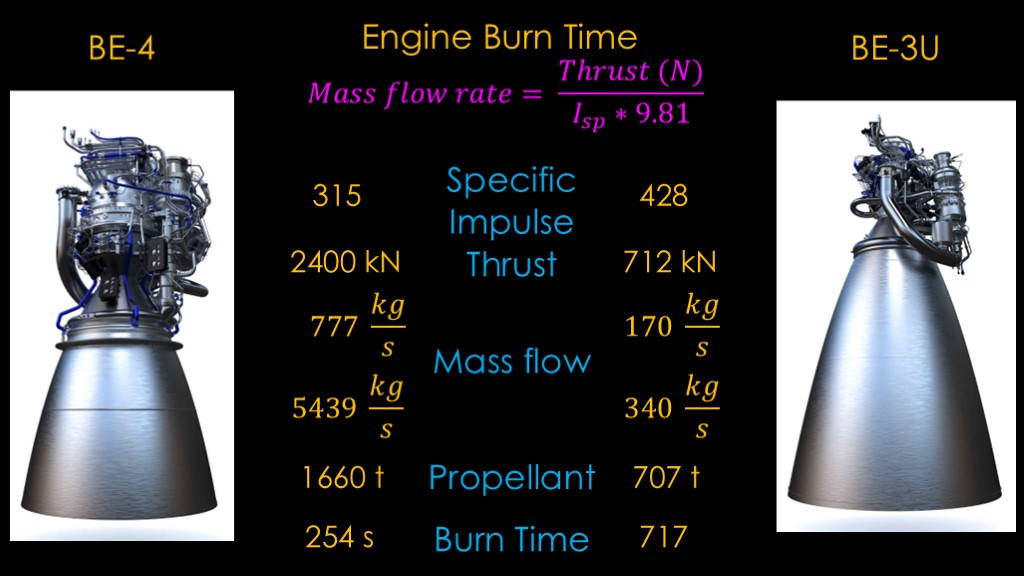
Since we have the propellant mass for each stage, we can figure out how long the engines can burn on that amount of propellant - assuming that they are burning at 100% thrust.
To do this, we'll need to figure out that mass flow rate, which is equivalent to the thrust in Newtons divided by the specific impulse multiplied by 9.81.
This seems a little arbitrary, but in rockets you create thrust by throwing mass out the back, and the amount of thrust is controlled by how much mass you throw out per second and how fast you throw it. The specific impulse is just how fast you throw it in meters per second divided by 9.81.
The specific impulse of the BE-4 is about 315 at sea level. The BE-3U is about 428, which is decent but not exceptional for a hydrogen upper stage.
Putting in the thrust, we can calculate the mass flow of the BE-4 at 777 kilograms per second and the BE-3U at 170 kilograms per second.
Multiply that by the number of engines per stage, and that gives us the stage mass flow. Finally, divide the total propellant we calculated earlier by the stage mass flow rate, and that gives us 254 seconds for the first stage and 717 seconds for the second stage.
That 254 seconds seems like a very long time.
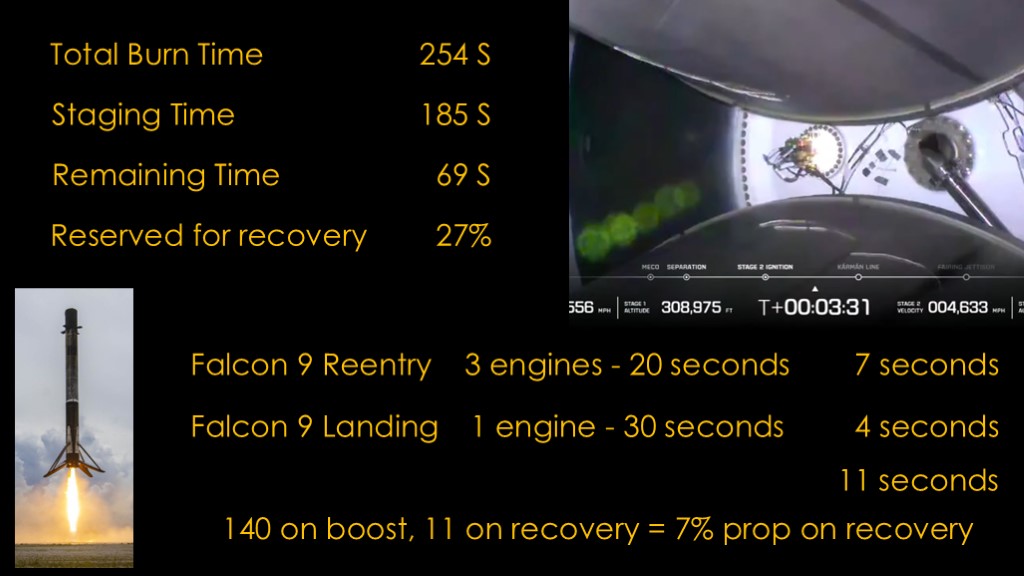
The observed staging time on the first flight was 185 seconds, leaving 69 seconds of burn unaccounted for. The Wikipedia page says 190 seconds, so we're close enough.
New Glenn does need to reserve propellant for landing, and if our numbers are right, they would have 27% propellant left over.
What is realistic for propulsive landing?
Falcon 9 on a droneship landing uses 3 engines for 20 seconds for the reentry burn, or about 7 seconds of full burn, and 1 engine for 30 seconds for the landing burn, or about 4 seconds. 140 seconds on boost, 11 on recovery, for 7% propellant used for recovery.
That implies that New Glenn is allocating about 4 times the amount of propellant for landing. Falcon 9 is a highly optimized system, but 27% seems very high.
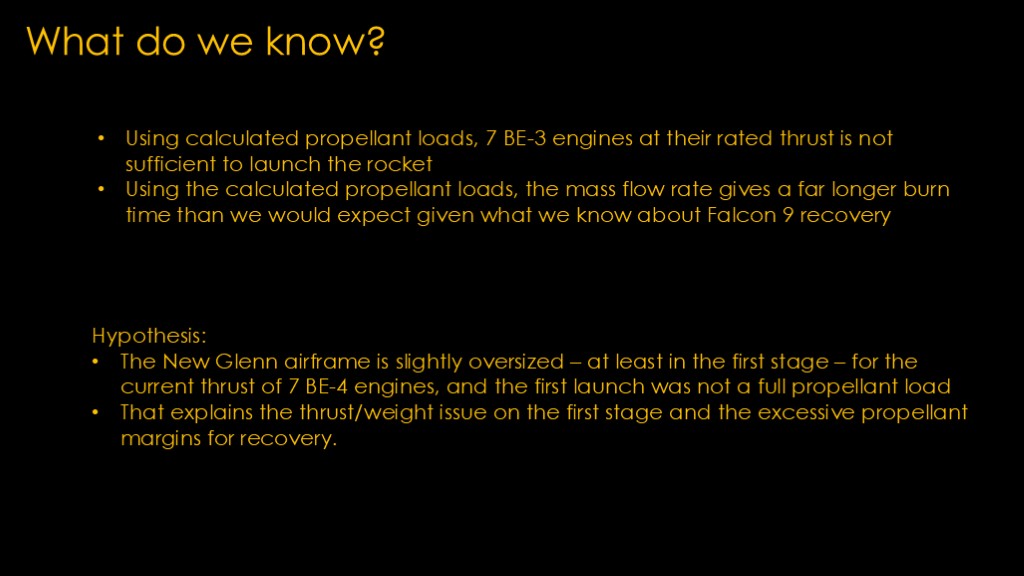

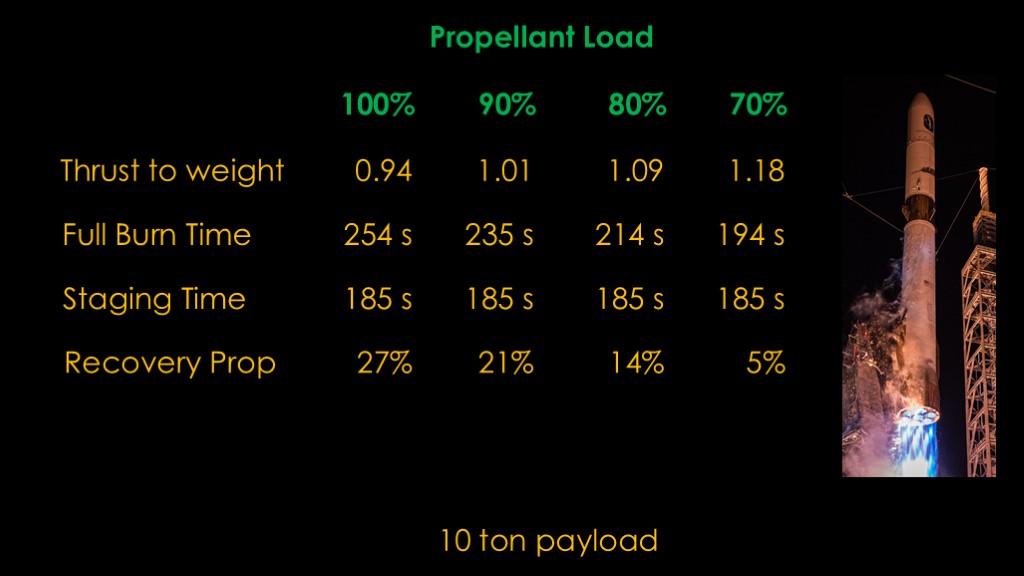
What have we found out?
We found out that the thrust to weight for New Glenn is unnaturally low - it appears that it shouldn't be able to launch, but it obviously does.
We also find that New Glenn appears to reserve over a quarter of its propellant for landing, which is likely far more than is needed.
What are we missing?
We need a lighter rocket, and since we can't easily make the structure lighter, our only option is to load less propellant.
We'll cut it down from 100% to 90%, 80%, and 70%.
90% doesn't do much; we can barely get off the pad. 70% looks like we don't have enough margin to land the booster.
But 80% looks really interesting. Thrust to weight looks about right, and 14% fuel margin is about double what Falcon 9 has.
This seems promising.
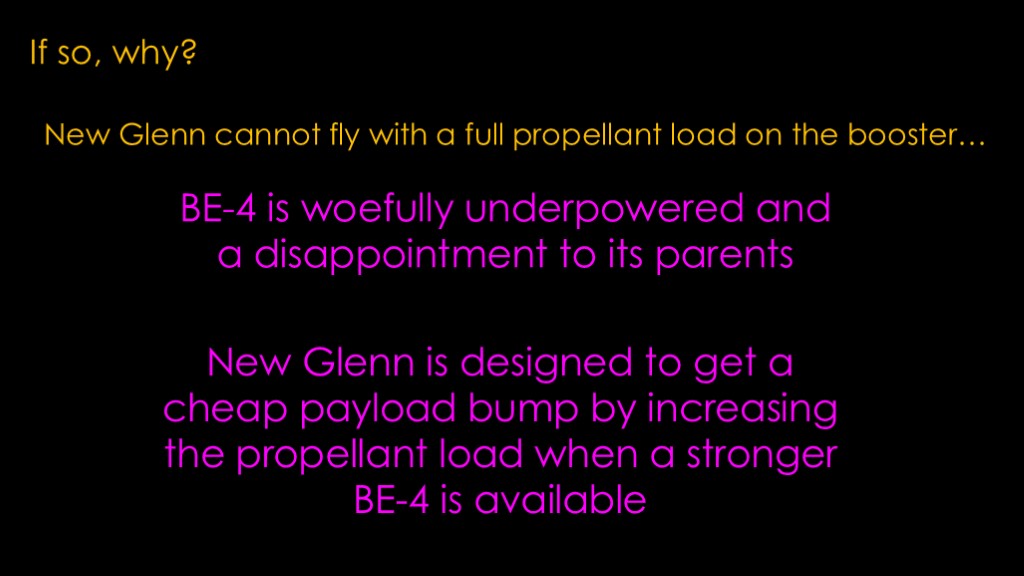
It seems that New Glenn cannot fly with a full propellant load on the booster. What is going on?
The obvious answer is that BE-4 is a disappointment to its parents, as it just can't generate the performance needed to launch the full rocket.
I believe the obvious answer is wrong.
What I think is going on is that Blue Origin is engaging in a bit of future proofing. They designed a rocket that can fly with the current BE-4 performance levels with a partial propellant load but can provide a nice bump in performance when a stronger BE-4 is available.
They are trading off a small amount of extra dry mass - and associated loss of performance - in the first stage for the ability to upgrade without having to build a bigger rocket.
If this is true, it's a pretty smart move in my opinion. My quick estimate is that doing this costs them perhaps 3 tons of payload, which seems like a small price to pay for a launcher that can do 45 tons to low earth orbit.
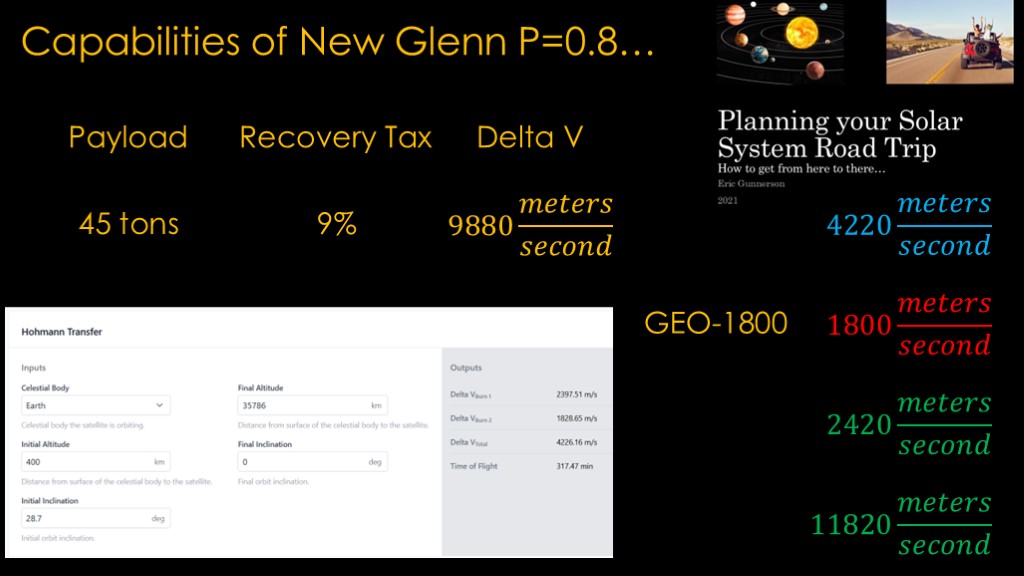
But can it do 45 tons to low earth orbit?
I'm going to spare you the details of the calculations as there's already too much math; if you want more, go watch my planning your solar system road trip video
If they can land the booster using only 9% of the propellant, my calculations suggest that they can give a 45 ton payload 9880 meters per second of delta v, and that's over 400 meters over the usual threshold of 9400 meters per second that I use for low earth orbit. The slow takeoff means they'll lose some extra delta v in gravity losses and they might spend more propellant on recovery, but it's in the right ballpark.
What about payload to geosynchronous transfer orbit? Getting from a 400 km low earth orbit to the final geosynchronous destination takes about 4220 meters per second of delta v, according to the excellent SatCatalog Hohmann transfer orbit calculator.
Geosynchronous transfer orbit payloads are typically quoted to GEO-1800, which means 1800 meters per second less than what it takes to get all the way to geo, or only 2420 meter/second above getting to that 400 kilometer geo orbit. That gives us a total of 11820 meters per second to put a payload in a GEO-1800 orbit.
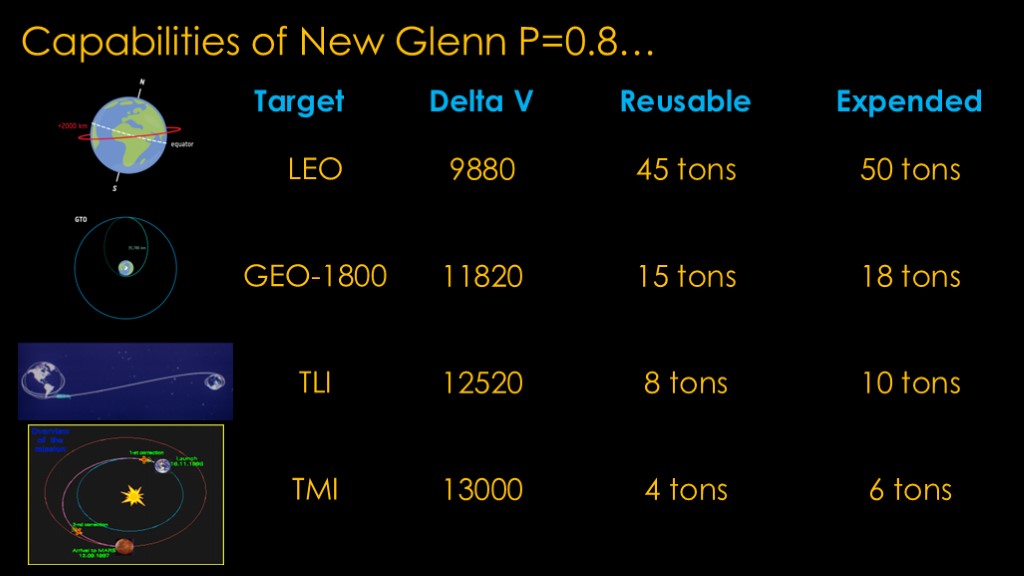
My model says that New Glenn can do 45 tons to low earth orbit in reusable model.
It also says that New Glenn could put about 15 tons into Geosynchronous transfer orbit, and Blue Origin says 13 tons, so the model is giving useful numbers, though it's about 15% too high. That's probably due to higher gravity losses and the mass of the recovery hardware.
8 tons to the moon, and 4 tons to mars.
This explains how New Glenn will be able to launch NASA's escapade probes to Mars without using the most efficient orbits that only come up every 22 months - The two escapade probes only mass 180 kilograms for both, and that means there's an extra 500 meters per second of delta v to spend on a less efficient orbit.
From this analysis, it looks like the current version of New Glenn will meet their targets.
A BE-4 version 2 probably bumps the reusable payload to about 55 tons.
All these numbers assume a 9% recovery propellant tax.
Go fully expendable, and this is what my model says.

To Blue Origin, I want to say Kudos - New Glenn is a significant technical achievement.
But what does the existence of a flying New Glenn mean?
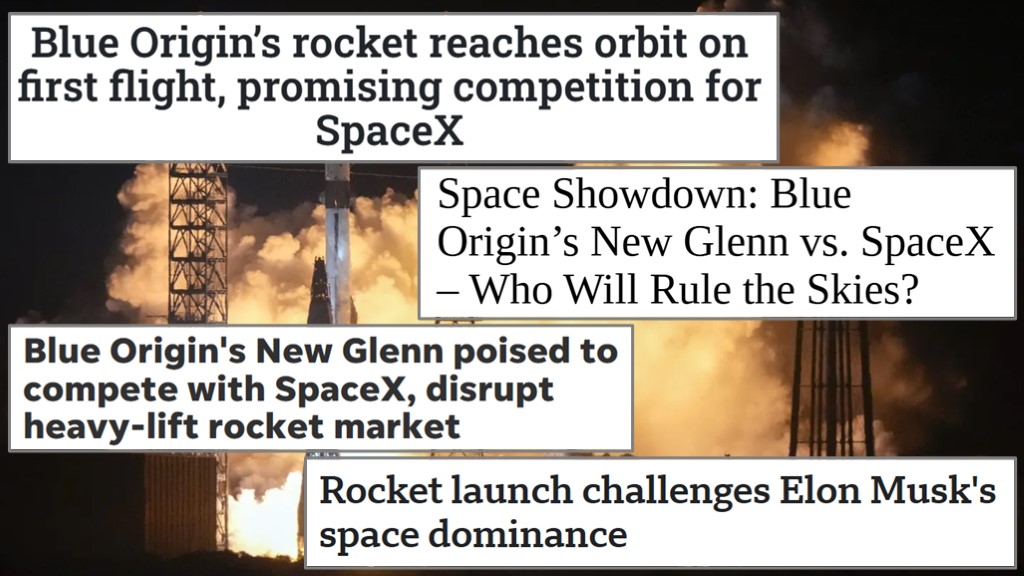
The press was happy to tell us, with article after article describing the epic battle between Musk and Bezos.
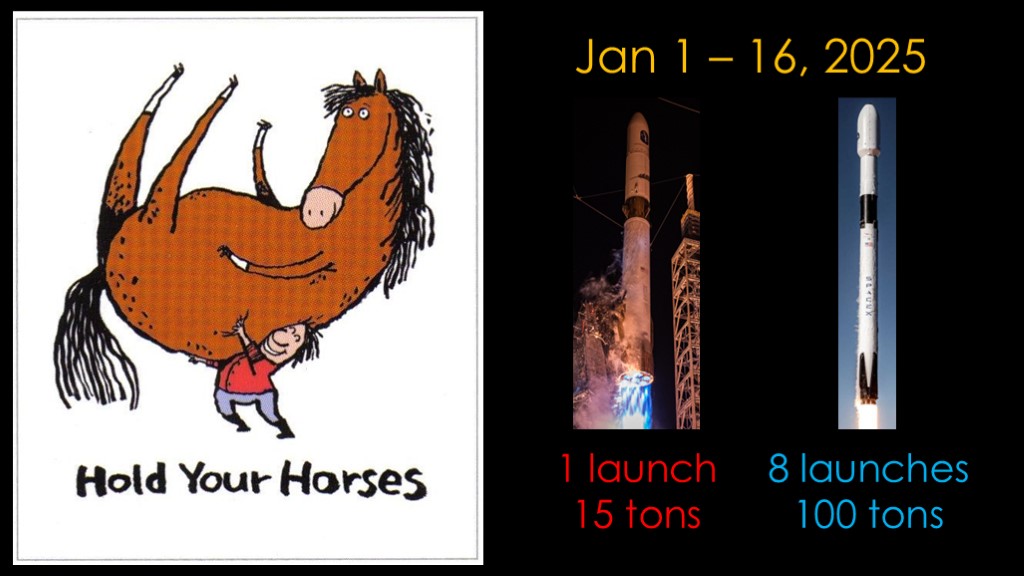
The press loves the Battle of the Billionaires storyline, and it presumably generates a lot of clicks, but hold your horses...
In the first 16 days of 2025, New Glenn had its first launch and carried about 15 tons into orbit.
Falcon 9 had a typical cadence and performed 8 launches that put about 100 tons into orbit.
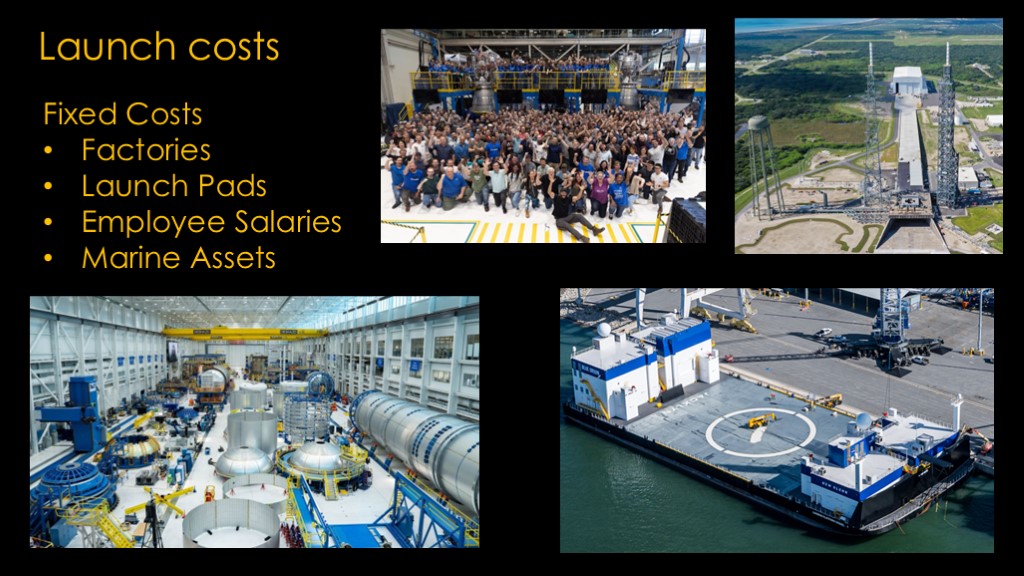
What will ultimately matter for New Glenn is how much it costs to perform a launch.
There are two sources of costs.
There are the fix costs - the cost to run factories and launch pads, the salaries of all the employees, and the marine assets used for recovery.
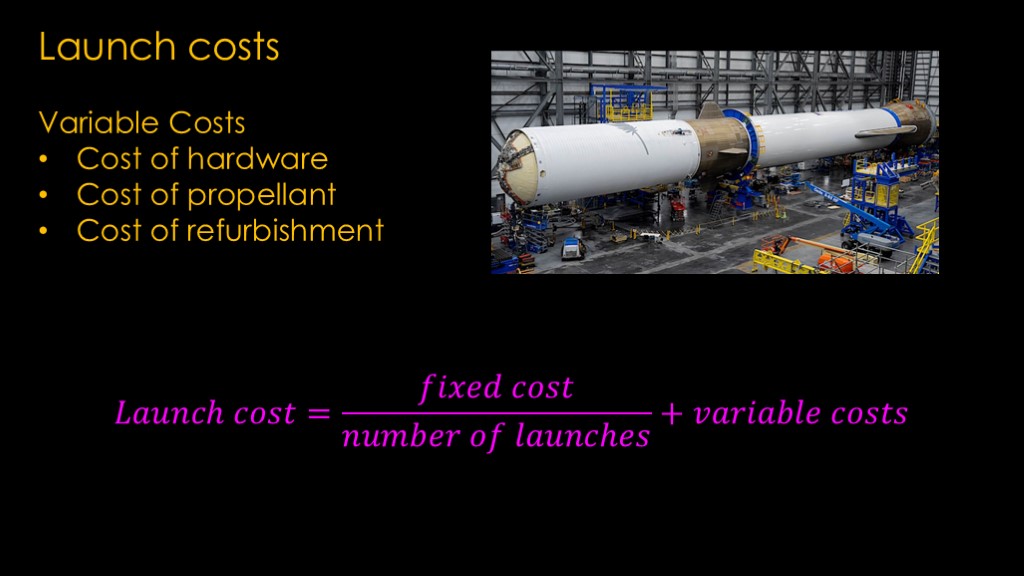
And there are variable costs, the cost of hardware, propellant, and refurbishment.
To figure out our overall launch cost, we need to divide the fixed cost by the number of launches in a year and add in the variable costs.
That means that the flight rate has a huge impact on your launch cost and therefore on the price that you can charge and still make a profit.

It's the heartbreak of low launch rate...
Your cost per launch is high because you aren't launching very much. You would like to launch more to drive your cost per launch down, but you can't attract customers because high cost per launch means your prices are too high.

That is why most new launchers talk about flying a lot
Last fall, Jarrett Jones, Senior vice president for new glenn said, "we have talked about 12 launches in 2025, and then we are looking to double it".
It seems that the first flight of New Glenn has not led to an outbreak of sanity at Blue Origin, though this January Blue Origin CEO Dave Limp retracted the outlandish 12 launch target for 2025 and substituted an equally outlandish 10 flight target.
It's this sort of thing that makes it really hard to take New Glenn seriously.
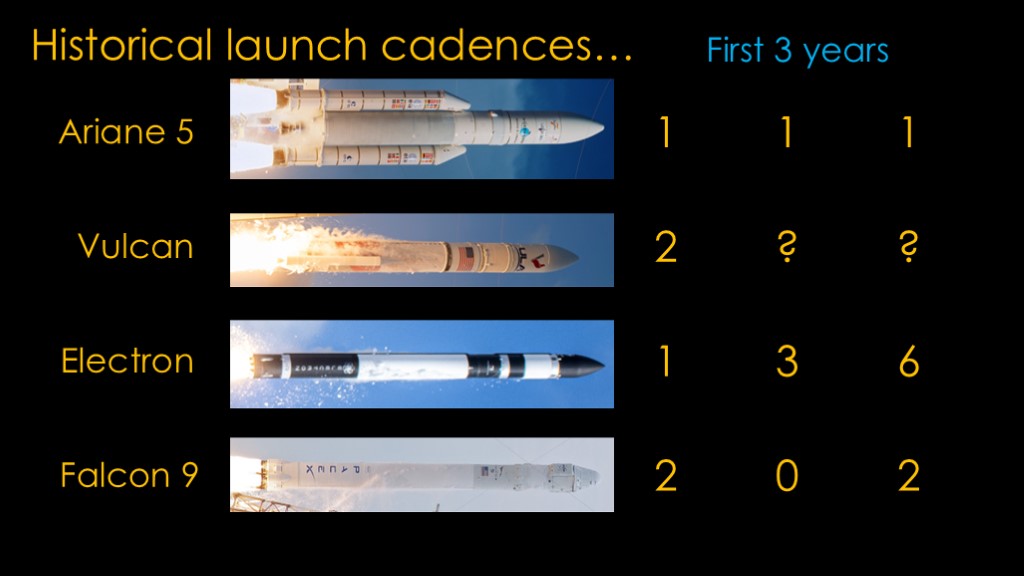
Let's look at some historical launch cadences for commercial launchers.
Ariane 5 launched once in each of the first 3 years it flew, though that was in tandem with a lot of Ariane 4 launches.
Vulcan flew only twice in its first year, but it was likely constrained by both payload and engine availability. Note that Blue Origin is not alone in their irrationality - ULA CEO Tory Bruno said in October of 2024 that Vulcan would be ramping up to 25 launches or more during 2025.
Electron flew once in its first year, 3 times in its second year, and 6 times the following year. That 3 to 6 cadence is what RocketLab Founder Peter Beck is saying for Neutron in its first two years.
Falcon 9 flew twice in its first year, not at all for a year, and then twice in the third year.
Most new rockets have some issues that need to be addressed from early flights and they also generally need payloads to launch to make flying worthwhile.
I think 3 times in 2025 would be a good cadence for New Glenn. They need to complete an incident investigation on the landing failure for the booster, and the incident investigation for a New Shepard failure in 2023 took 14 months before their next flight.
I'd be surprised to see more than 6 Vulcan flights this year, especially as they are sharing a launch pad with the remaining Atlas V launches and Amazon looks to be ready to start Kuiper launches.

The usual counter to this is that Jeff Bezos is rich, and can afford to lose money on launches.
Bezos certainly is extremely rich, but he is currently funding Blue Origin to the tune of $2 to 2.5 billion per year.
If they fly 20 flights a year and the lost $50 million per flight, that's an extra $1 billion dollars per year, or a 50% increase in cost.
One of Blue's missions is to radically reduce the cost of access to space, and subsidizing launches is not a great way to do that.
They also run the risk of being sued for predatory pricing.
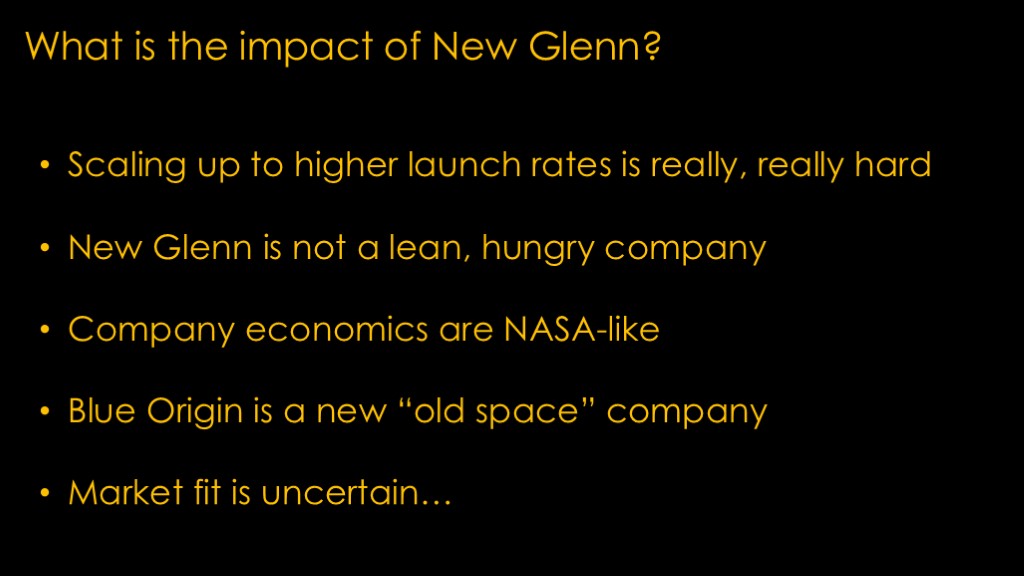
What will the impact of New Glenn be?
It's hard to predict.
I do know that scaling up to higher launch rates is really, really hard.
I also know that New Glenn is not a lean, hungry company, the way SpaceX was when it started and the way companies like Rocket Lab and Stoke are today. It seems unlikely that they can compete with the SpaceX Juggernaut, and I'm not even sure they can compete against Rocket Lab's Neutron, ULA's Vulcan, and Ariane's Ariane 6 - all organizations who have a launch history and know how to run launch operations well.
And I have my same concerns about internal economics. From what I can tell, none of the Blue Origin projects have ever made a profit and that means that they are lacking the "competitive pricing that customers want" development gene - like NASA, the take in money from the outside and spend it on projects.
This is hard to fix because there are literally thousands of individual decisions that determine your launch prices and you need the right culture to keep things lean.
To put it another way, Blue Origin is a new company with an old space approach.
It's also not clear where New Glenn fits in the current launch market. I did some slides on that topic but there are too many changes there and it wanted to be a separate video, so look for that in the near future.

If you like new glenn, try Glenn Classic...